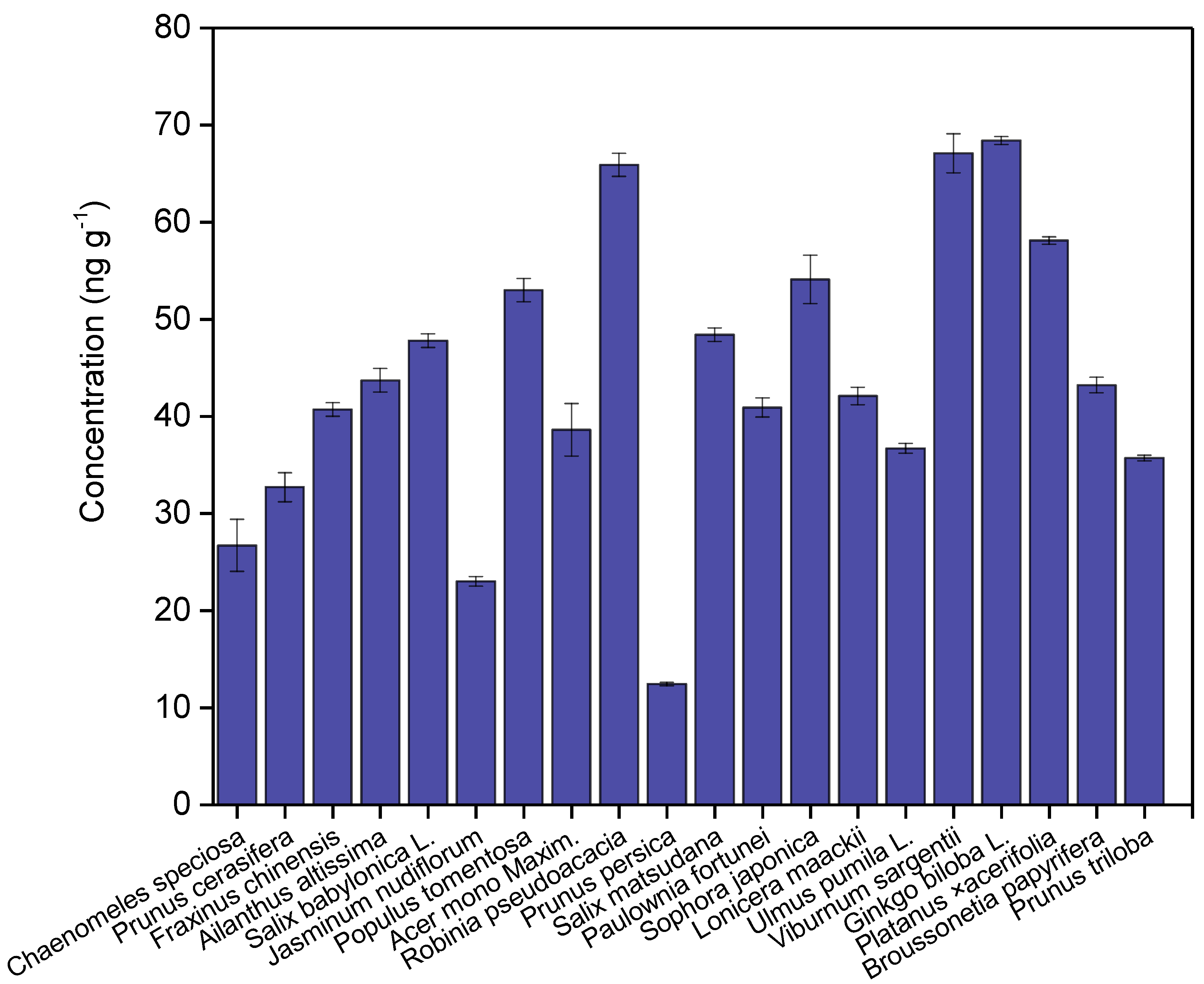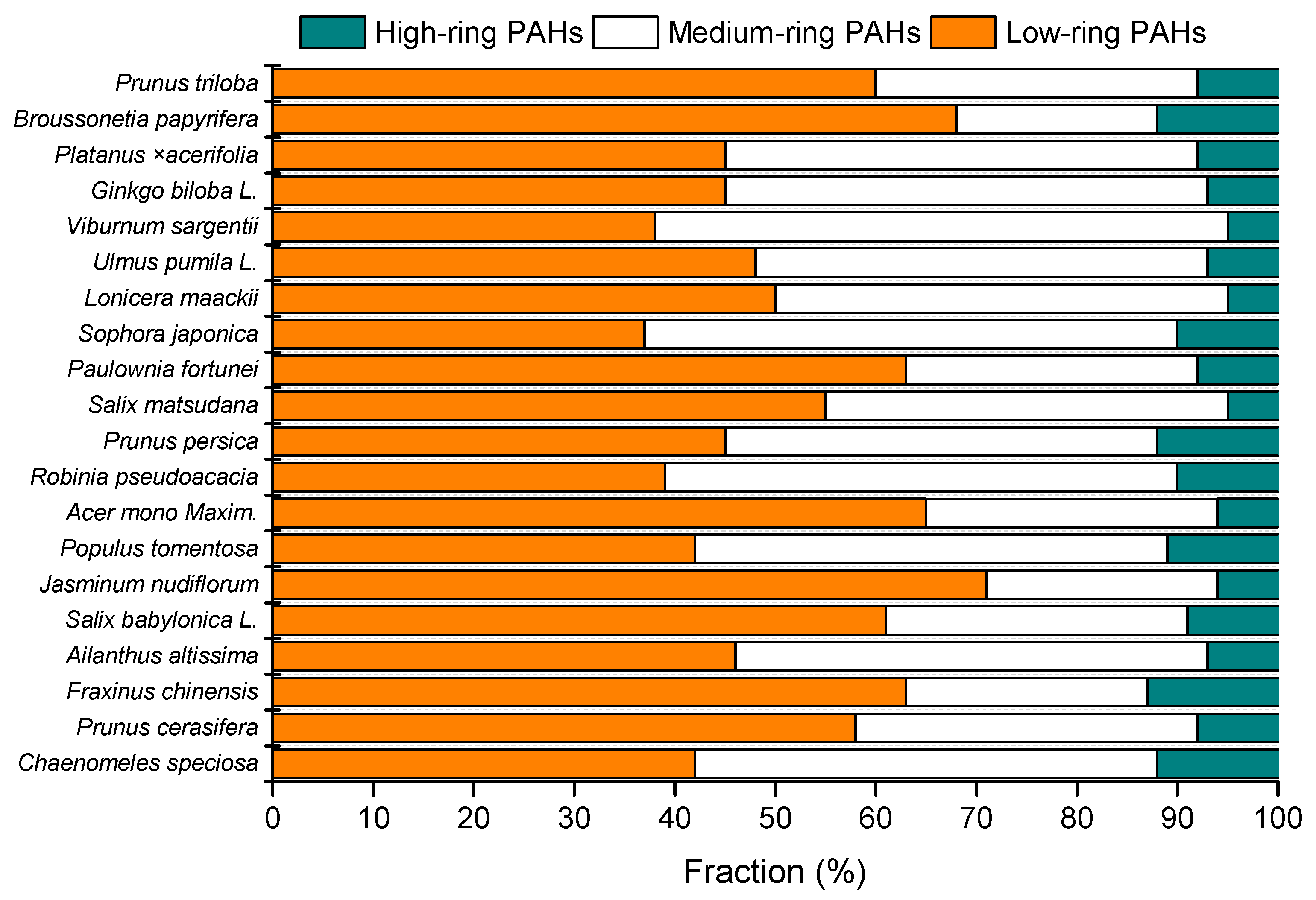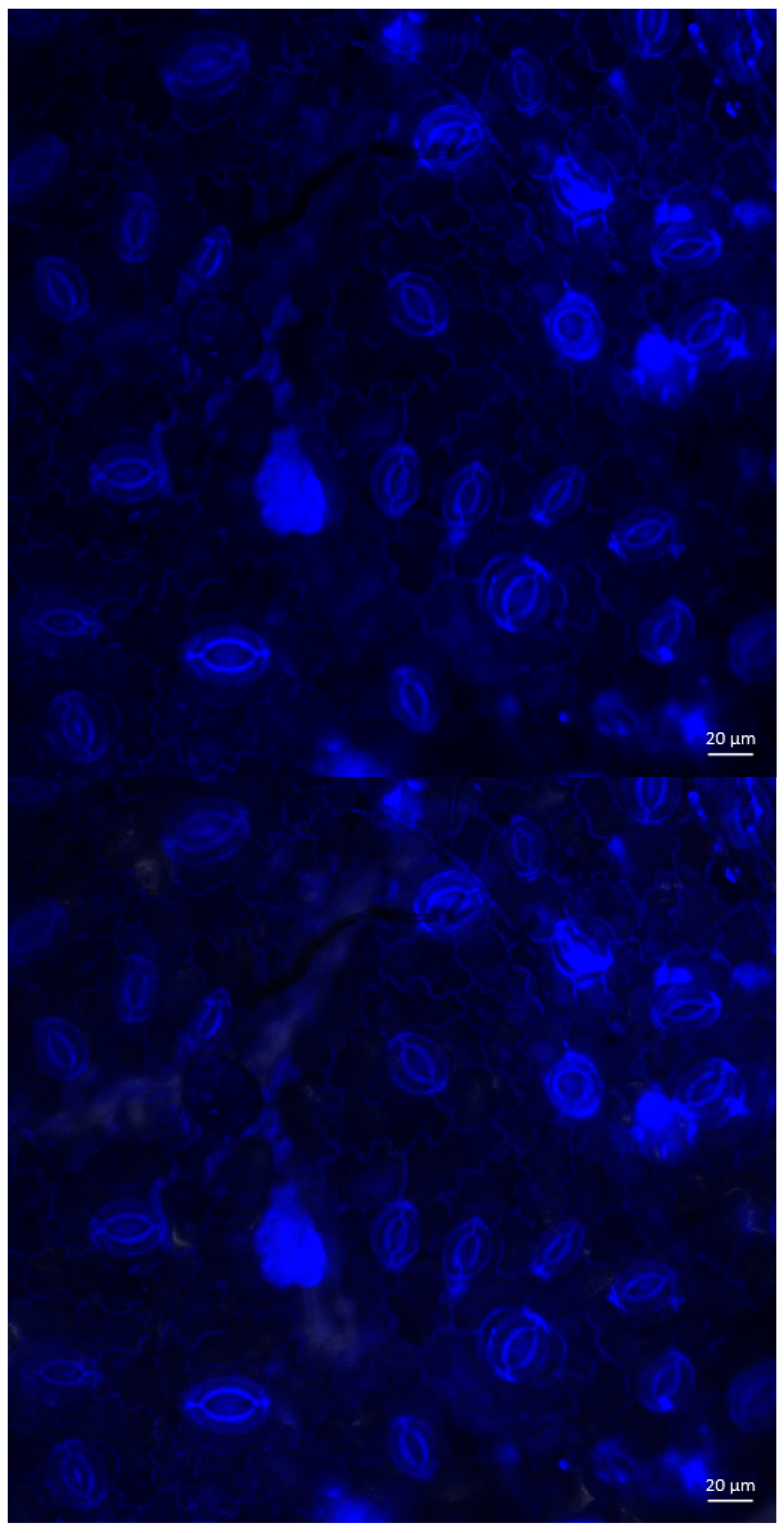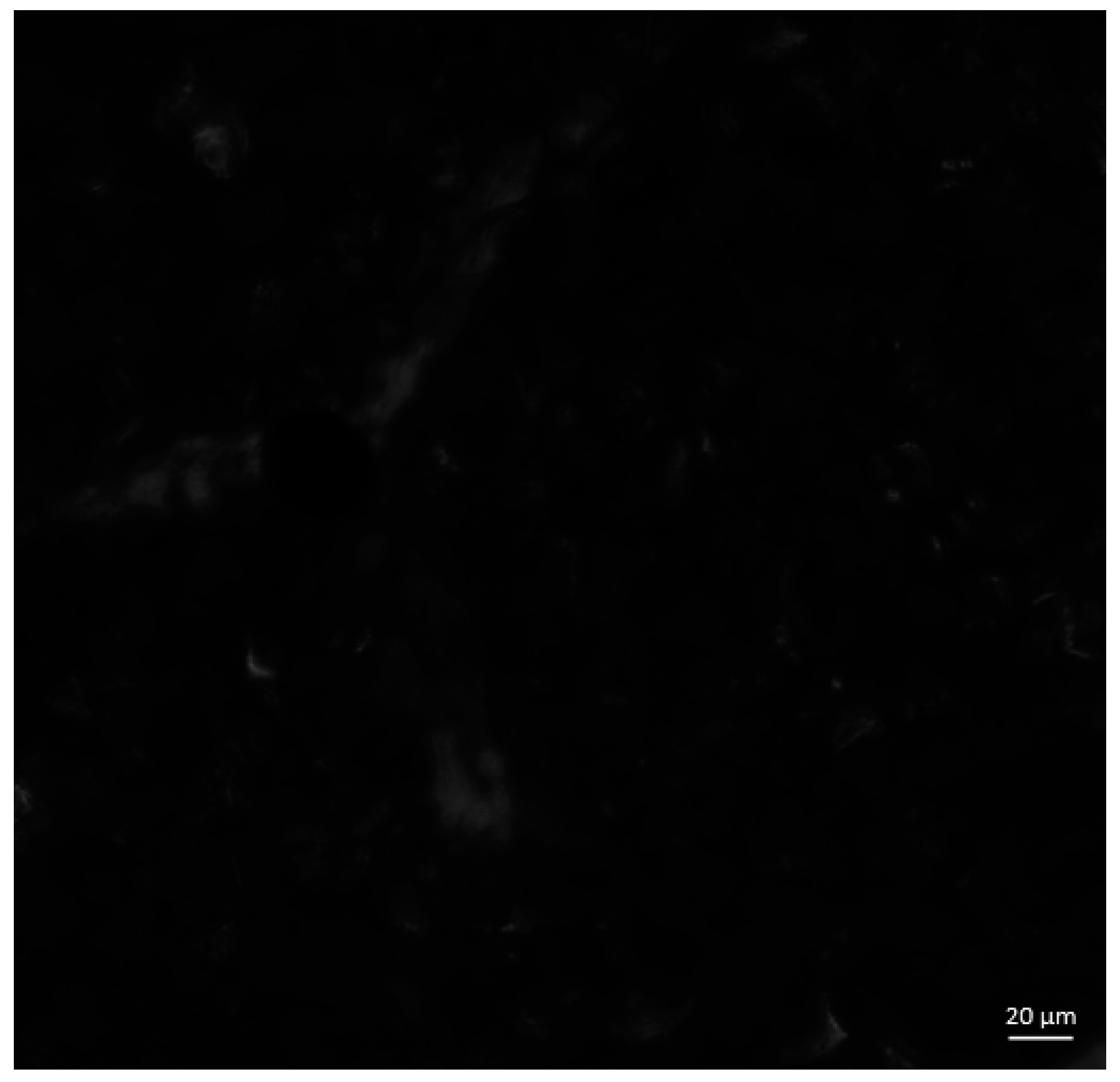Occurrences of Deposited Polycyclic Aromatic Hydrocarbons in Wax of Plant Leaves Using Laser Scanning Microscopy and Gas Chromatography–Mass Spectrometry
Abstract
1. Introduction
2. Materials and Methods
2.1. Chemicals
2.2. Leaf Samples Collection
2.3. Measurements of PAHs in Leaf Samples
2.4. Observation of PAHs on Plant Leaves through Laser Scanning Microscopy
2.5. Statistical Analysis
3. Results and Discussion
3.1. Differences in the Accumulation of PAHs across Species
3.2. Observation of PAHs on Plant Leaves
4. Conclusions
Supplementary Materials
Author Contributions
Funding
Institutional Review Board Statement
Informed Consent Statement
Data Availability Statement
Conflicts of Interest
References
- Hümmler, A.; Bayer, V.J.; Achten, C. Unravelling mixed sources of polycyclic aromatic hydrocarbons (PAH) in urban soils by visual characterization of anthropogenic substrates and coal particles, 71 PAH and alkylated PAH patterns. Environ. Pollut. 2024, 342, 123029. [Google Scholar] [CrossRef] [PubMed]
- Zhang, Y.; Meliefste, K.; Hu, W.; Portengen, L.; Rothman, N.; Reiss, B.; Li, J.; Xu, J.; Ning, B.; Liu, D.; et al. Expanded PAH analysis of household air pollution in a rural region of China with high lung cancer incidence. Environ. Pollut. 2024, 361, 124717. [Google Scholar] [CrossRef] [PubMed]
- Patnana, D.P.; Chandra, B.P.; Chaudhary, P.; Sinha, B.; Sinha, V. Optimized LC-MS/MS method for simultaneous determination of endocrine disruptors and PAHs bound to PM2.5: Sources and health risk in 357 Indo-Gangetic Plain. Atmos. Environ. 2022, 290, 119363. [Google Scholar] [CrossRef]
- Ali-Taleshi, M.S.; Moeinaddini, M.; Riyahi Bakhtiari, A.; Feiznia, S.; Squizzato, S.; Bourliva, A. A one-year monitoring of spatiotemporal variations of PM2.5-bound PAHs in Tehran, Iran: Source apportionment, local and regional sources origins and source-specific cancer risk assessment. Environ. Pollut. 2021, 274, 115883. [Google Scholar] [CrossRef]
- Faridi, S.; Yousefian, F.; Roostaei, V.; Harrison, R.M.; Azimi, F.; Niazi, S.; Naddafi, K.; Momeniha, F.; Malkawi, M.; Moh’d Safi, H.A.; et al. Source apportionment, identification and characterization, and emission inventory of ambient particulate matter in 22 Eastern Mediterranean Region countries: A systematic review and recommendations for good practice. Environ. Pollut. 2022, 310, 119889. [Google Scholar] [CrossRef] [PubMed]
- Nim, N.; Morris, J.; Tekasakul, P.; Dejchanchaiwong, R. Fine and ultrafine particle emission factors and new diagnostic ratios of PAHs for peat swamp forest fires. Environ. Pollut. 2023, 335, 122237. [Google Scholar] [CrossRef] [PubMed]
- Wu, Y.; Zhang, H.; Zhang, H.; Zeng, T.; Qiao, N.; Shi, Y.; Zhang, N.; Luo, W.; Lu, S. Risks and sources of atmospheric particulate-bound polycyclic aromatic hydrocarbons (AP-PAHs) in seven regions of China: A review. Urban Clim. 2024, 57, 102108. [Google Scholar] [CrossRef]
- Wang, J.; Xia, L.; Wang, R. Provincial emission inventory of atmospheric polycyclic aromatic hydrocarbons (PAHs) in China. Atmos. Environ. 2024, 334, 120729. [Google Scholar] [CrossRef]
- Wang, D.-Q.; Jia, S.-M.; Liu, L.-Y.; Zhang, Z.-F.; Zhu, F.-J.; Ma, W.-L. Pollution characteristics, source apportionment and absorption spectra of size-resolved PAHs in atmospheric particles in a cold megacity of China. J. Hazard. Mater. 2024, 473, 134643. [Google Scholar] [CrossRef]
- Sun, J.; Shen, Z.; Niu, X.; Yu, J.; Zhang, Y.; Liu, S.; Niu, X.; Zhang, Y.; Xu, H.; Li, X.; et al. PM2.5 source profiles from typical Chinese commercial cooking activities in northern China and its influences on bioreactivity of vascular smooth muscle cells (VSMCs). Atmos. Environ. 2020, 239, 117750. [Google Scholar] [CrossRef]
- EPA. Polynculear Aromatic Hydrogens, SW-846 Method 8310; United States Environmental Protection Agency: Washington, DC, USA, 1999. [Google Scholar]
- Magalhães, K.M.; Carreira, R.S.; Rosa Filho, J.S.; Rocha, P.P.; Santana, F.M.; Yogui, G.T. Polycyclic aromatic hydrocarbons (PAHs) in fishery resources affected by the oil spill in Brazil: Short-term environmental health and seafood safety. Mar. Pollut. Bull. 2022, 175, 113334. [Google Scholar] [CrossRef] [PubMed]
- Badyda, A.J.; Rogula-Kozłowska, W.; Majewski, G.; Bralewska, K.; Widziewicz-Rzońca, K.; Piekarska, B.; Rogulski, M.; Bihałowicz, J.S. Inhalation risk to PAHs and BTEX during barbecuing: The role of fuel/food type and route of exposure. J. Hazard. Mater. 2022, 440, 129635. [Google Scholar] [CrossRef]
- Zapelini de Melo, A.P.; Hoff, R.B.; Molognoni, L.; de Oliveira, T.; Daguer, H.; Manique Barreto, P.L. Disasters with oil spills in the oceans: Impacts on food safety and analytical control methods. Food Res. Int. 2022, 157, 111366. [Google Scholar] [CrossRef] [PubMed]
- Ahad, J.M.E.; Macdonald, R.W.; Parrott, J.L.; Yang, Z.; Zhang, Y.; Siddique, T.; Kuznetsova, A.; Rauert, C.; Galarneau, E.; Studabaker, W.B.; et al. Polycyclic aromatic compounds (PACs) in the Canadian environment: A review of sampling techniques, strategies and instrumentation. Environ. Pollut. 2020, 266, 114988. [Google Scholar] [CrossRef] [PubMed]
- Yang, M.; Tian, S.; Liu, Q.; Yang, Z.; Yang, Y.; Shao, P.; Liu, Y. Determination of 31 polycyclic aromatic hydrocarbons in plant leaves using internal standard method with ultrasonic extraction-gas chromatography-mass spectrometry. Toxics 2022, 10, 634. [Google Scholar] [CrossRef] [PubMed]
- Shen, G.; Du, W.; Zhuo, S.; Yu, J.; Tao, S. Improving regulations on residential emissions and non-criteria hazardous contaminants—Insights from a field campaign on ambient PM and PAHs in North China Plain. Environ. Sci. Policy 2019, 92, 201–206. [Google Scholar] [CrossRef]
- Gautam, K.; Anbumani, S. Chapter 19—Ecotoxicological effects of organic micro-pollutants on the environment. In Current Developments in Biotechnology and Bioengineering; Varjani, S., Pandey, A., Tyagi, R.D., Ngo, H.H., Larroche, C., Eds.; Elsevier: Amsterdam, The Netherlands, 2020; pp. 481–501. [Google Scholar]
- Tiwari, M.; Sahu, S.K.; Pandit, G.G. Distribution of PAHs in different compartment of creek ecosystem: Ecotoxicological concern and human health risk. Environ. Toxicol. Pharmacol. 2017, 50, 58–66. [Google Scholar] [CrossRef]
- Dhokale, B.; Saeed, Z.M.; Ali, W.A.; Mohamed, S. Chapter 10—Recent advances in quantification and remediation technologies for toxic PAH mitigation from the environment. In Advances in Nano and Biochemistry; Morajkar, P., Naik, M., Eds.; Academic Press: New York, NY, USA, 2023; pp. 233–258. [Google Scholar]
- Mishra, A.; Kumari, M.; Swati; Kumar, R.; Iqbal, K.; Thakur, I.S. Persistent organic pollutants in the environment: Risk assessment, hazards, and mitigation strategies. Bioresour. Technol. Rep. 2022, 19, 101143. [Google Scholar] [CrossRef]
- Bolan, S.; Padhye, L.P.; Mulligan, C.N.; Alonso, E.R.; Saint-Fort, R.; Jasemizad, T.; Wang, C.; Zhang, T.; Rinklebe, J.; Wang, H.; et al. Surfactant-enhanced mobilization of persistent organic pollutants: Potential for soil and sediment remediation and unintended consequences. J. Hazard. Mater. 2023, 443, 130189. [Google Scholar] [CrossRef]
- Udom, G.J.; Frazzoli, C.; Ekhator, O.C.; Onyena, A.P.; Bocca, B.; Orisakwe, O.E. Pervasiveness, bioaccumulation and subduing environmental health challenges posed by polycyclic aromatic hydrocarbons (PAHs): A systematic review to settle a one health strategy in Niger Delta, Nigeria. Environ. Res. 2023, 226, 115620. [Google Scholar] [CrossRef]
- Song, Q.; Li, X.; Zhao, Z.; Li, D.; Li, Y.; Hou, N. Insights into ecotoxicity effects of PAHs and ecosystem responses of remediation strategies under cold stress: From PAHs degradation to ecological restoration regulated by signal molecular. Chem. Eng. J. 2023, 475, 146042. [Google Scholar] [CrossRef]
- Mukhopadhyay, S.; Dutta, R.; Das, P. A critical review on plant biomonitors for determination of polycyclic aromatic hydrocarbons (PAHs) in air through solvent extraction techniques. Chemosphere 2020, 251, 126441. [Google Scholar] [CrossRef]
- Robin, S.L.; Marchand, C. Polycyclic aromatic hydrocarbons (PAHs) in mangrove ecosystems: A review. Environ. Pollut. 2022, 311, 119959. [Google Scholar] [CrossRef] [PubMed]
- Klingberg, J.; Strandberg, B.; Sjöman, H.; Taube, M.; Wallin, G.; Pleijel, H. Polycyclic aromatic hydrocarbon (PAH) accumulation in Quercus palustris and Pinus nigra in the urban landscape of Gothenburg, Sweden. Sci. Total Environ. 2022, 805, 150163. [Google Scholar] [CrossRef] [PubMed]
- Brennan, A.; Moreno Jiménez, E.; Alburquerque, J.A.; Knapp, C.W.; Switzer, C. Effects of biochar and activated carbon amendment on maize growth and the uptake and measured availability of polycyclic aromatic hydrocarbons (PAHs) and potentially toxic elements (PTEs). Environ. Pollut. 2014, 193, 79–87. [Google Scholar] [CrossRef] [PubMed]
- Mandal, M.; Das, S.; Roy, A.; Rakwal, R.; Jones, O.A.H.; Popek, R.; Agrawal, G.K.; Sarkar, A. Interactive relations between plants, the phyllosphere microbial community, and particulate matter pollution. Sci. Total Environ. 2023, 890, 164352. [Google Scholar] [CrossRef]
- Tian, S.; Liu, Q.; Qu, J.; Yang, M.; Ma, Q.; Liu, J.; Shao, P.; Liu, Y. Whole-transcriptome analysis on the leaves of 433 Rosa chinensis Jacq. under exposure to polycyclic aromatic hydrocarbons. Toxics 2023, 11, 610. [Google Scholar] [CrossRef] [PubMed]
- Wang, Y.; Zhang, Z.; Xu, Y.; Rodgers, T.F.M.; Ablimit, M.; Li, J.; Tan, F. Identifying the contributions of root and foliage gaseous/particle uptakes to indoor plants for phthalates, OPFRs and PAHs. Sci. Total Environ. 2023, 883, 163644. [Google Scholar] [CrossRef] [PubMed]
- Sun, H.; Guo, S.; Nan, Y.; Ma, R. Direct determination of surfactant effects on the uptake of gaseous parent and alkylated PAHs by crop leaf surfaces. Ecotoxicol. Environ. Saf. 2018, 154, 206–213. [Google Scholar] [CrossRef]
- Tian, L.; Yin, S.; Ma, Y.; Kang, H.; Zhang, X.; Tan, H.; Meng, H.; Liu, C. Impact factor assessment of the uptake and accumulation of polycyclic aromatic hydrocarbons by plant leaves: Morphological characteristics have the greatest impact. Sci. Total Environ. 2019, 652, 1149–1155. [Google Scholar] [CrossRef]
- Bakker, M.I.; Koerselman, J.W.; Tolls, J.; Kollöffel, C. Localization of deposited polycyclic aromatic hydrocarbons in leaves of Plantago. Environ. Toxicol. Chem. 2001, 20, 1112–1116. [Google Scholar] [CrossRef]
- Prigioniero, A.; Zuzolo, D.; Niinemets, Ü.; Postiglione, A.; Mercurio, M.; Izzo, F.; Trifuoggi, M.; Toscanesi, M.; Scarano, P.; Tartaglia, M.; et al. Particulate matter and polycyclic aromatic hydrocarbon uptake in relation to leaf surface functional traits in Mediterranean evergreens: Potentials for air phytoremediation. J. Hazard. Mater. 2022, 435, 129029. [Google Scholar] [CrossRef]
- Eamus, D.; Prior, L. Ecophysiology of trees of seasonally dry tropics: Comparisons among phenologies. In Advances in Ecological Research; Academic Press: New York, NY, USA, 2001; Volume 32, pp. 113–197. [Google Scholar]
- Bertini, A.; Niccolini, G.; Gennari, R.; Lozar, F.; Menichetti, E.; Natalicchio, M.; Dela Pierre, F. Terrestrial and marine dynamics on the brink of the Messinian salinity crisis: A wet scenario from the northern Mediterranean. Glob. Planet. Change 2024, 233, 104362. [Google Scholar] [CrossRef]
- Makarska-Bialokoz, M. Spectroscopic evidence of xanthine compounds fluorescence quenching effect on water-soluble porphyrins. J. Mol. Struct. 2015, 1081, 224–232. [Google Scholar] [CrossRef]




Disclaimer/Publisher’s Note: The statements, opinions and data contained in all publications are solely those of the individual author(s) and contributor(s) and not of MDPI and/or the editor(s). MDPI and/or the editor(s) disclaim responsibility for any injury to people or property resulting from any ideas, methods, instructions or products referred to in the content. |
© 2024 by the authors. Licensee MDPI, Basel, Switzerland. This article is an open access article distributed under the terms and conditions of the Creative Commons Attribution (CC BY) license (https://creativecommons.org/licenses/by/4.0/).
Share and Cite
Yang, M.; Liu, Q.; Tian, S.; Yang, Z.; Yang, Y.; Shao, P.; Liu, Y. Occurrences of Deposited Polycyclic Aromatic Hydrocarbons in Wax of Plant Leaves Using Laser Scanning Microscopy and Gas Chromatography–Mass Spectrometry. Atmosphere 2024, 15, 1165. https://doi.org/10.3390/atmos15101165
Yang M, Liu Q, Tian S, Yang Z, Yang Y, Shao P, Liu Y. Occurrences of Deposited Polycyclic Aromatic Hydrocarbons in Wax of Plant Leaves Using Laser Scanning Microscopy and Gas Chromatography–Mass Spectrometry. Atmosphere. 2024; 15(10):1165. https://doi.org/10.3390/atmos15101165
Chicago/Turabian StyleYang, Ming, Qingyang Liu, Shili Tian, Zheng Yang, Yifan Yang, Peng Shao, and Yanju Liu. 2024. "Occurrences of Deposited Polycyclic Aromatic Hydrocarbons in Wax of Plant Leaves Using Laser Scanning Microscopy and Gas Chromatography–Mass Spectrometry" Atmosphere 15, no. 10: 1165. https://doi.org/10.3390/atmos15101165
APA StyleYang, M., Liu, Q., Tian, S., Yang, Z., Yang, Y., Shao, P., & Liu, Y. (2024). Occurrences of Deposited Polycyclic Aromatic Hydrocarbons in Wax of Plant Leaves Using Laser Scanning Microscopy and Gas Chromatography–Mass Spectrometry. Atmosphere, 15(10), 1165. https://doi.org/10.3390/atmos15101165








